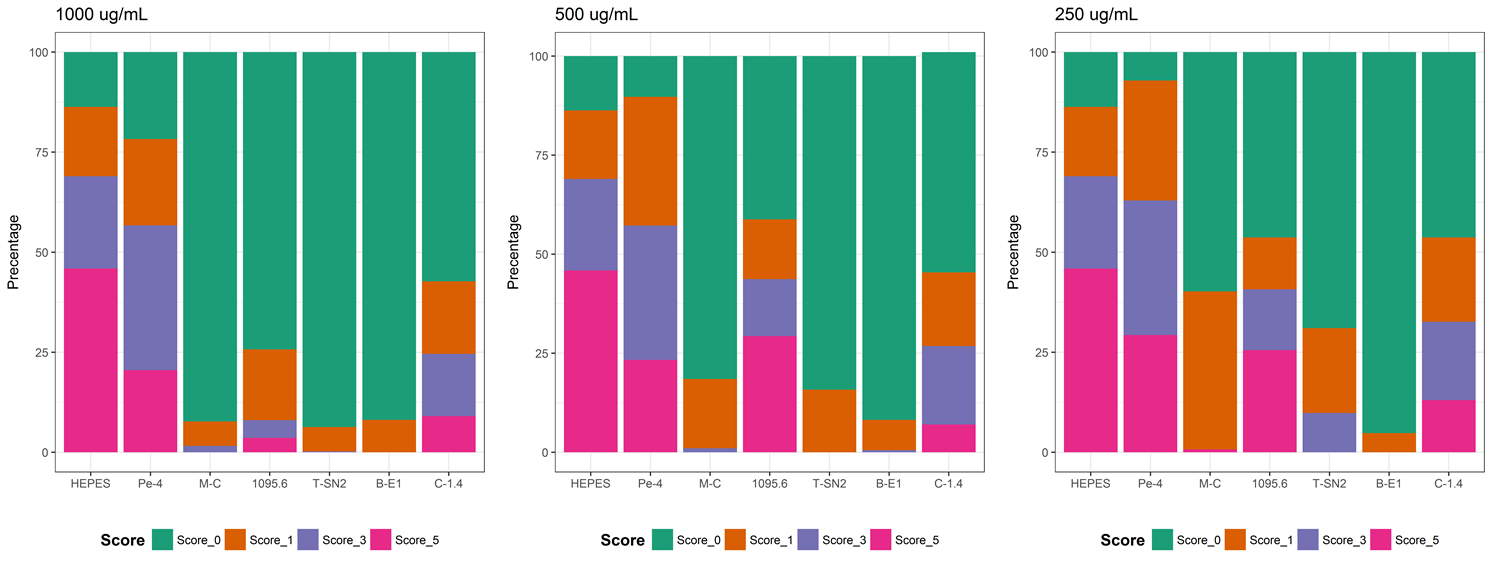Difference between revisions of "Part:BBa K2262023"
| Line 3: | Line 3: | ||
<partinfo>BBa_K2262023 short</partinfo> | <partinfo>BBa_K2262023 short</partinfo> | ||
| − | + | <br> | |
| + | <br> | ||
| + | <br> | ||
| + | [[File:Composite part C-1.4.png|800px|thumb|center|'''Figure 1.''' P<sub>T7</sub>+RBS+C-1.4+terminator ]] | ||
| + | |||
| + | <br> | ||
| + | <br> | ||
| + | |||
| + | <h1>'''Introduction'''</h1> | ||
| + | |||
| + | <br> | ||
| + | |||
| + | | ||
| + | C-1.4 is a peptide from <i>Litoria xanthomera</i> [1]. The score of SCM analysis shows its promising potential to be antifungal. | ||
| + | |||
| + | <br> | ||
| + | |||
| + | <h1>'''Scoring Card Predict'''</h1> | ||
| + | |||
| + | | ||
| + | C-1.4 got 401.2 from the Antifungal Scoring Card of Parabase System. The score is over 353, the threshold to divide whether a peptide has an antifungal function probability, that means C-1.4 has a high probability to have an antifungal function. | ||
| + | <br> | ||
| + | <br> | ||
| + | |||
| + | [[File:Scoreing card C-1.4.png|800px|thumb|center|'''Figure 2.''' The sequence of C-1.4. <br> | ||
| + | The colors of each amino acids represent the probability of anti-fungal dipeptides. ]] | ||
| + | |||
| + | <br> | ||
| + | |||
| + | |||
| + | <h1>'''Experiment'''</h1> | ||
| + | |||
| + | <br> | ||
| + | |||
| + | <p style="padding:1px;font-size:16px"><b>1. Inhibition Zone </b></p> | ||
| + | |||
| + | | ||
| + | The result shows that the place we put C-1.4 will have no hole. It means the peptide might not affect the growth of mycelium. | ||
| + | |||
| + | |||
| + | [[File:Inhibition zone C-1.4.png|400px|thumb|center|'''Figure 3.''' The result shows that C-1.4 has no function on affecting the growth of mycelium.]] | ||
| + | |||
| + | <BR> | ||
| + | <p style="padding:1px;font-size:16px"><b>2. Spore Germination </b></p> | ||
| + | | ||
| + | The result shows that the spore germination percentage of non-germinating spores adding C-1.4 with a concentration of 1000 μg/mL was higher than adding the negative control, which means the spore germination is inhibited by peptides and proves the peptides are effective. We can get the same result from adding C-1.4 with a concentration of 500 μg/mL and 250 μg/mL . | ||
| + | |||
| + | |||
| + | |||
| + | [[File:Spore Germination.png|900px|thumb|center|'''Figure 4.''' The result shows that C-1.4 may affect the germination of spore. ]] | ||
| + | |||
| + | |||
| + | <br> | ||
| + | <br> | ||
| + | |||
| + | <h1>'''Reference'''</h1> | ||
| + | [1]SIMON T. STEINBORNER; GRAEME J. CURRIE; JOHN H. BOWIE; JOHN C. WALLACE; MICHAEL J. TYLER. | ||
| + | "New antibiotic caerin 1 peptides from the skin secretion of the Australian tree frog Litoria chloris. Comparison of the activities of the caerin 1 peptides from the genus Litoria"Volume 51, Issue 2, February 1998, Pages 121–126. | ||
| + | <br> | ||
| + | <br> | ||
<!-- Add more about the biology of this part here | <!-- Add more about the biology of this part here | ||
Latest revision as of 02:25, 15 February 2018
T7 Promoter+RBS+C-1.4
Introduction
C-1.4 is a peptide from Litoria xanthomera [1]. The score of SCM analysis shows its promising potential to be antifungal.
Scoring Card Predict
C-1.4 got 401.2 from the Antifungal Scoring Card of Parabase System. The score is over 353, the threshold to divide whether a peptide has an antifungal function probability, that means C-1.4 has a high probability to have an antifungal function.
Experiment
1. Inhibition Zone
The result shows that the place we put C-1.4 will have no hole. It means the peptide might not affect the growth of mycelium.
2. Spore Germination
The result shows that the spore germination percentage of non-germinating spores adding C-1.4 with a concentration of 1000 μg/mL was higher than adding the negative control, which means the spore germination is inhibited by peptides and proves the peptides are effective. We can get the same result from adding C-1.4 with a concentration of 500 μg/mL and 250 μg/mL .
Reference
[1]SIMON T. STEINBORNER; GRAEME J. CURRIE; JOHN H. BOWIE; JOHN C. WALLACE; MICHAEL J. TYLER.
"New antibiotic caerin 1 peptides from the skin secretion of the Australian tree frog Litoria chloris. Comparison of the activities of the caerin 1 peptides from the genus Litoria"Volume 51, Issue 2, February 1998, Pages 121–126.
Sequence and Features
- 10COMPATIBLE WITH RFC[10]
- 12COMPATIBLE WITH RFC[12]
- 21COMPATIBLE WITH RFC[21]
- 23COMPATIBLE WITH RFC[23]
- 25COMPATIBLE WITH RFC[25]
- 1000COMPATIBLE WITH RFC[1000]




